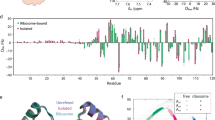Abstract
Segmental isotope labelling enables the NMR study of an individual domain within a multidomain protein, but still in the context of the entire full-length protein. Compared to the fully labelled protein, spectral overlap can be greatly reduced. We here describe segmental labelling of the (double-) hexameric DnaB helicase from Helicobacter pylori using a ligation approach. Solid-state spectra demonstrate that the ligated protein has the same structure and structural order as the directly expressed full-length protein. We uniformly 13C/15N labeled the N-terminal domain (147 residues) of the protein, while the C-terminal domain (311 residues) remained in natural abundance. The reduced signal overlap in solid-state NMR spectra allowed to identify structural “hotspots” for which the structure of the N-terminal domain in the context of the oligomeric full-length protein differs from the one in the isolated form. They are located near the linker between the two domains, in an α-helical hairpin.




Similar content being viewed by others
References
Baldus M, Petkova AT, Herzfeld J, Griffin RG (1998) Cross polarization in the tilted frame: assignment and spectral simplification in heteronuclear spin systems. Mol Phys 95:1197–1207
Bazin A, Cherrier MV, Gutsche I, Timmins J, Terradot L (2015) Structure and primase-mediated activation of a bacterial dodecameric replicative helicase. Nucleic Acids Res 43:8564–8576
Böckmann A et al (2009) Characterization of different water pools in solid-state NMR protein samples. J Biomol NMR 45:319–327
Corn JE, Berger JM (2006) Regulation of bacterial priming and daughter strand synthesis through helicase-primase interactions. Nucleic Acids Res 34:4082–4088
Fogh R et al (2002) The CCPN project: an interim report on a data model for the NMR community. Nat Struct Mol Biol 9:416–418
Frederick KK et al (2017) Combining DNP NMR with segmental and specific labeling to study a yeast prion protein strain that is not parallel in-register. Proc Natl Acad Sci 114:3642–3647
Gardiennet C et al (2012) A sedimented sample of a 59 kDa dodecameric helicase yields high-resolution solid-state NMR spectra. Angew Chem Int Ed 51:7855–7858
Gor’kov PL et al (2007) Low-E probe for 19F–1H NMR of dilute biological solids. J Magn Reson 189:182–189
Gupta S, Tycko R Segmental isotopic labeling of HIV-1 capsid protein assemblies for solid state NMR. J Biomol NMR 70:103–114 (2018)
Higman V et al (2009) Assigning large proteins in the solid state: a MAS NMR resonance assignment strategy using selectively and extensively 13C-labelled proteins. J Biomol NMR 44:245–260
Hiller S, Fiorito F, Wüthrich K, Wider G (2005) Automated projection spectroscopy (APSY). Proc Natl Acad Sci USA 102:10876–10881
Hiller S, Wider G, Wüthrich K (2008) APSY-NMR with proteins: practical aspects and backbone assignment. J Biomol NMR 42:179–195
Kashav T et al (2009) Three-dimensional structure of N-terminal domain of DnaB helicase and helicase-primase interactions in Helicobacter pylori. PLoS ONE 4:e7515
Lacabanne D, Meier BH, Böckmann A Selective labeling and unlabeling strategies in protein solid-state NMR spectroscopy. J Biomol NMR (2017)
Liu D, Xu R, Cowburn D (2009) Chapter 8 segmental isotopic labeling of proteins for nuclear magnetic resonance. Methods Enzymol 462:151–175
Michel E, Allain FHT (2015) Selective amino acid segmental labeling of multi-domain proteins. Methods Enzymol 565:389–422
Michel E, Skrisovska L, Wüthrich K, Allain FHT (2013) Amino acid-selective segmental isotope labeling of multidomain proteins for structural biology. ChemBioChem 14:457–466
Schubeis T, Lührs T, Ritter C (2015a) Unambiguous assignment of short- and long-range structural restraints by solid-state NMR spectroscopy with segmental isotope labeling. ChemBioChem 16:51–54
Schubeis T et al (2015b) Untangling a repetitive amyloid sequence: correlating biofilm-derived and segmentally labeled curli fimbriae by solid-state NMR spectroscopy. Angew Chem Int Ed 54:14669–14672
Stevens T et al (2011) A software framework for analysing solid-state MAS NMR data. J Biomol NMR 51:437–447
Studier FW (2005) Protein production by auto-induction in high-density shaking cultures. Protein Expr Purif 41:207–234
Takegoshi K, Nakamura S, Terao T (2001) 13C–1H dipolar-assisted rotational resonance in magic-angle spinning NMR. Chem Phys Lett 344:631–637
Vitali F et al (2006) Structure of the two most C-terminal RNA recognition motifs of PTB using segmental isotope labeling. EMBO J 25:150–162
Volkmann G, Iwai H (2010) Protein trans-splicing and its use in structural biology: opportunities and limitations. Mol BioSyst 6:2110–2121
Vranken WF et al (2005) The CCPN data model for NMR spectroscopy: development of a software pipeline. Proteins 59:687–696
Wiegand T et al (2016a) Variability and conservation of structural domains in divide-and-conquer approaches. J Biomol NMR 65:79–86
Wiegand T et al (2016b) Solid-state NMR sequential assignments of the N-terminal domain of HpDnaB helicase. Biomol NMR Assign 10:13–23
Wiegand T et al (2016c) Monitoring ssDNA Binding to the DnaB helicase from Helicobacter pylori by solid-state NMR spectroscopy. Angew Chem Int Ed 55:14164–14168
Williamson MP (2013) Using chemical shift perturbation to characterise ligand binding. Prog Nucl Magn Reson Spectrosc 73:1–16
Xue J, Burz DS, Shekhtman A (2012) Segmental labeling to study multidomain proteins. In: Atreya HS (ed) Isotope labeling in biomolecular NMR. Springer, Dordrecht, pp 17–33
Acknowledgements
This work was supported by the Swiss National Science Foundation (Grant 200020_159707), and the ETH Career SEED-69 16-1. This project has received funding from the European Research Council (ERC) under the European Union’s Horizon 2020 research and innovation programme (Grant Agreement No. 741863, FASTER).
Author information
Authors and Affiliations
Corresponding authors
Electronic supplementary material
Below is the link to the electronic supplementary material.
Rights and permissions
About this article
Cite this article
Wiegand, T., Cadalbert, R., von Schroetter, C. et al. Segmental isotope labelling and solid-state NMR of a 12 × 59 kDa motor protein: identification of structural variability. J Biomol NMR 71, 237–245 (2018). https://doi.org/10.1007/s10858-018-0196-z
Received:
Accepted:
Published:
Issue Date:
DOI: https://doi.org/10.1007/s10858-018-0196-z



